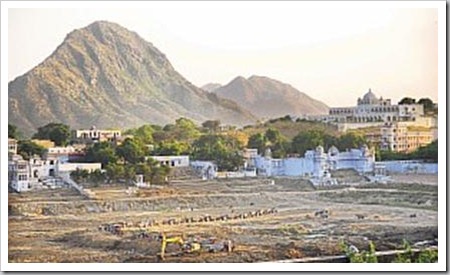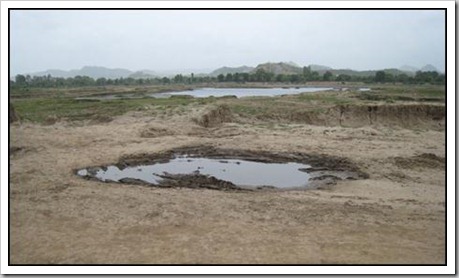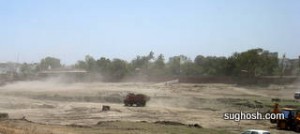As it is not practicable to reverse the slow process of silting in the bed of lakes through which only silt can be removed, there is no word like ‘desilting’ in any standard English dictionary. What we are doing in the name of ‘desilting’ is practically ‘digging’ or ‘excavation’ of lake bed. By so called desilting, the original lake bed is disturbed which has far reaching adverse effects on the performance of the lake. Most visible effect is the increase in percolation rate resulting in heavy seepage losses through the lake bed as observed after massive desilting at Pushkar lake in 2009.
Increasing storage capacity by digging lake bed is the most costly proposal when compared to other alternatives and therefore needs study of alternatives as well as detailed hydrological investigations considering available yield, existing storage capacity, down-stream needs, etc. As overflowing of a lake is necessary to keep the river alive in the downstream and to flush out the static water of the lake, if a lake does not overflow at least once in four years on an average, there is no need to increase the storage capacity. Instead of desilting, the long term solution is to treat the catchment area so that silt load in the incoming flow is permanently reduced. This can be done by contour bunding, check dams, massive plantation, etc. which will be less costly but will have far reaching positive effects of permanent nature.
Desilting, if not done in a planned way, creates isolated pits of considerable size in the submergence area which may have lower bottom levels than the main storage. Because of this isolation, water collected in these pits never reach to the main storage, it only seeps or evaporates. Thus, desilting said to be carried out for increasing storage capacity, practically reduces the actual utilizable storage in most of the cases.
Removing surface soil to check eutrophication, is like giving treatment for symptoms instead of the disease. Unless we check the inflow of untreated sewage in lakes, it is not possible to reduce the nitrate or phosphate contents. Therefore, it is better to invest funds on checking of sewage inflow than on removing surface soil for the purpose so as to have permanent solution of the problem.
When used in farms and gardens, silt acts as a natural manure and increases water holding capacity of the soil. It is also an essential ingredient of the soil mix used for making bricks, kelus, etc. Because of this, silt is regularly taken away by the beneficiaries at their own cost and the off take is sometimes even more than the deposition. Thus, instead of spending money on desilting, the government should charge royalty for the silt used by beneficiaries considering it as a mineral. This will generate funds for regular maintenance of lakes. Full article is given below.
CONSERVATION OF LAKES –
MYTHS AND REALITIES ABOUT DESILTING
There is a general feeling that the main reason for frequent drying up of lakes is their reduced storage capacity due to regular siltation over the years and therefore desilting should be the major component of any Lake Conservation Project. Lakes, which are in near vicinity of towns get polluted due to neglect on the part of society and when tested, the results of B.O.D. as well as nitrates and phosphate content of the stored water show eutrophic conditions. This becomes another reason for advocating desilting of the lakes, for a certain depth, said to contain such polluted contents. Presently, there are three important lake conservation projects in progress in Rajasthan, namely Pushkar lake near Ajmer and Fatehsagar and Pichola lakes in Udaipur. Desilting is a major component of the proposed works in all these projects on which crores of rupees are being invested.
If we refer standard English dictionaries, there is no word like ‘desilting’. On referring online dictionaries, such as dictionary.com, the nearest word suggested is ‘desalting’. However, ‘silt’ is a very common term and the dictionary meaning is –
“A sedimentary material consisting of grains or particles of disintegrated rock, smaller than sand and larger than clay. The diameter of the particles ranges from 0.0039 to 0.0625 mm. Silt is often found at the bottom of bodies of water where it accumulates slowly by settling through the water.”
Thus, we can call ‘silting’ as the process of slow accumulation of silt in the bottom of water bodies. Since, practically, there can not be any reversal of this process, by which we can remove only the deposited silt through a slow process, there is no word like ‘desilting’. What we are doing in the name of ‘desilting’ is practically ‘digging’ or ‘excavation’ of lake bed and while doing so, no one can claim that only deposited silt has been removed and the original lake bed has not been touched. Particularly, when we use heavy excavation machinery, there are all chances that in addition to the deposited silt, the strata of original lake bed will also get removed in the desilting operations. There is no specified boundary or visible difference between the deposited silt above the original bed and the soil of original lake bed. Further to this, there is no provision to check the particle size of the excavated muck so as to see that only silt is removed. Thus, by the so called desilting, the original lake bed is disturbed which has far reaching adverse effects on the performance of the lake. Most visible effect is the increase in percolation rate resulting in heavy seepage losses through the lake bed. The reason being this that by massive digging, the thin sealing layer of compacted silt deposited year after year of lake filling is disturbed and the joints of original strata get exposed. This has actually happened after massive desilting at Pushkar lake in 2009 as reported in the Times of India, 24th October, 2009 issue which reads as under –
“While till last year the lake was 
full (it even had enough water in summer), this year it is a dried-up excavation site. Ironically, the lake has gone dry because of a Rs 50 cr government project to clean it up and make it deeper. Before the project was launched in 2007, the lake had at least five-feet water even during summer. But now there’s nothing. “When work started, the lake had 4-feet-and-3-inch water and the people of Pushkar were hopeful that they would soon have a cleaner, deeper lake, which had been desilted,” said Radhe Shyam Sharma of Pushkar Market Association. He said when last year the district administration started desilting work the lake became wider and deeper and as a result could not conserve rainwater for even a week. The lake’s depth was 15 feet, but this increased to 25 feet.”
Now, if we look to the said benefit of desilting as increase in storage capacity, then we have to first analyze the very basic need of increasing storage capacity of a particular lake and if the need is justified, then we have to look towards cost effective alternatives, as increasing storage capacity by digging the bed is the most costly proposal when compared to other alternatives like raising full tank level or even constructing a new lake in the up-stream. As we all know, unless there is sufficient yield, there is no necessity of increasing storage capacity. A simple test can be the past record of filling of a lake. In case it does not overflow at least thrice in four years on an average, there is no need to increase the storage capacity. Overflowing of a lake is necessary so to keep the river alive in the downstream and to flush out the static water of the lake. If the situation is this that a lake seldom overflows, then, increasing storage capacity will not serve any purpose. On the contrary, the probability of overflow will decrease and water level with the same storage will go down which will result in a poor look. This issue was discussed in the thirteenth meeting of Regional Committee for Hard Rock Regional Centre of National Institute of Hydrology held on 10th, April, 2002 at Hyderabad and the comments given in the minutes are as under –
“In the recent past, the general trend has been to desilt the tanks in order to increase their capacity without considering the nature of percolation and potential of yield. Therefore, it is necessary to evolve a balanced approach in desilting the tanks by studying the geohydrological input in assessing the development of tank. It is necessary to establish the water yield of the tank, area of influence of the tank, percolation rate of the tank, dependability of water for irrigation and drinking purposes and its feasibility, and effect of desilting of the tank.”
Even if, increasing of storage capacity is considered necessary on the basis of detailed investigations, then, we must look other cost effective alternatives like increasing the full tank level, construction of a new tank in up-stream, etc. It is well known that creating storage by excavation is the costliest alternative because created storage is just equal to the excavation quantity. For example, if we plan to increase the storage capacity of a lake by, say one million cubic meters, then we will have to excavate equal quantity in the bed and after bulking it will become about 1.40 million cubic meters to be transported and dumped elsewhere. Dumping needs considerable land as even if two meter thick layer is laid on an average, the area required for dumping works out to 0.70 million sq.m. To get this much of area for dumping, which will be in patches, considerable lead, say up to 10-12 kms. is involved which further increases the cost. The dump areas will either be in the up stream of lake or in the down stream of lake. The up-stream is catchment area of same lake and the down-stream is catchment of the next lake because there is a chain of lakes on any river. Thus, where ever dumped, the loose silt will erode very fast during next rains and most of it will be carried with the surface flow either to the same lake or to any other lake in the down-stream. This makes the whole exercise futile. The long term solution is to treat the catchment area so that silt load in the incoming flow is permanently reduced. This can be done by contour bunding, check dams, massive plantation, etc. which will be less costly but will have far reaching positive effects of permanent nature.
Desilting, if not done in a planned way, creates isolated pits of considerable size in the submergence area which may have lower bottom levels than the main storage. Because of this isolation, water collected in these pits never reach to the main storage, it only seeps s or evaporates. Such situation already exists in the bed of Pichola and Fatehsagar lakes of Udaipur as a result of massive desilting operations carried out with out proper planning. Thus, desilting said to be carried out for increasing storage capacity, practically reduces the actual utilizable storage in most of the cases.
s or evaporates. Such situation already exists in the bed of Pichola and Fatehsagar lakes of Udaipur as a result of massive desilting operations carried out with out proper planning. Thus, desilting said to be carried out for increasing storage capacity, practically reduces the actual utilizable storage in most of the cases.
Removing surface soil to check eutrophication, is like giving treatment for symptoms instead of the disease. Unless we check the inflow of untreated sewage in lakes, it is not possible to reduce the nitrate or phosphate contents. Therefore, it is better to invest funds on checking of sewage inflow than on removing surface soil for the purpose so as to have permanent solution of the problem. In addition to this, it not possible to remove the surface soil from whole of the bed unless the lake is completely dry. Partial removal of such contaminated surface soil does not serve any purpose. The B.O.D. and nitrate or phosphate concentration is related with the status of storage in a lake. If tests are conducted in late summer, when storage is less, the results will give higher alarming figures. But, if the same tests are conducted just after rains, the results will give lower figures due to dilution because of inflows, which may be well within permissible limits. Thus dilution and frequent overflow from a lake is more important than removing surface soil from part of lake bed to check eutrophication. Also, there are other economical ways like fisheries development, creating artificial floating cultivated wet lands, etc., to deal with the problem of eutrofication.
Silt gets deposited mostly at confluence point of flowing river or nallah and static stored water of a lake. This area gets exposed just after a few months of after rains and the silt can be taken out easily. When used in farms and gardens, this silt acts as a natural manure and increases water holding capacity of the soil. It is also an essential ingredient of the soil mix used for making bricks, kelus, earthen pots etc. Use of bricks is increasing day by day as R.C.C. framed constriction with partition walls is becoming more and more popular. Farm houses and gardens are also increasing these days. Because of such increasing use, silt is regularly taken away year after year by the beneficiaries at their own cost from such confluence points and the off take is sometimes even more than the deposition. In case of Pichola lake of Udaipur, due to over removal of silt as well as bed soil in the upper part of submergence, a lake within the lake was created and a link channel had to be dug for connecting both the storages. Thus, instead of desilting, actually check on removal of silt is required to control the off-take of silt. The situation warrants that instead of spending money on desilting, the government should charge royalty for the silt used by beneficiaries considering it as a mineral based on supply and demand situation. This will generate funds for regular maintenance of lakes.
In case of lakes, the stored water of which is used by cultivators for irrigation as well by industries, desilting of bed results in injustice with the cultivators. Desilting creates additional storage below canal sill and greater percentage of rain water is required to fill the dead storage capacity of the lake and less is available as live storage. The dead storage can not be used by cultivators because it remains below canal sill level. However, industries always use it as they pump water from the lake and for them there is no difference whether the water is below canal sill level or above canal sill level. This is actually happening at Udaisagar lake near Udaipur where Hindustan Zinc Ltd. is drawing water for their smelter. A few years back, the lake used to serve large command area but now irrigation is possible only in very good rainfall years.
Considering scarcity of water, it is thus very necessary to frame a well thought policy for approving desilting work in lake beds so that it does not have long term negative effects and wasteful expenditure.
– Gyan Prakash Soni, M.E. (Water Use Management) I.I.T. Roorkee
Note – This article was first presented at the National Seminar on Lake Conservation organized by College of Technology and Agriculture Engineering at Udaipur in February 2010 which has been reproduced here with minor modifications.



Awesome article! I like it very much!
Very helpful info. thanks so much, i just need it
I’d have to seek advice from you here. Which is not something It’s my job to do! I enjoy reading a post that will make people think. Also, thanks for allowing me personally to comment!
Thanks for your great article! It has been extremely helpful. I wish that you will continue sharing your wisdom with us.
I’m not sure where you are getting your information, but good topic. I needs to spend some time learning more or understanding more. Thanks for magnificent information I was looking for this info for my mission.
I found the info on this site beneficial.
Pretty nice post. I just stumbled upon your blog and wanted to say that I’ve really enjoyed browsing your blog posts. After all I’ll be subscribing to your feed and I hope you write again soon!
Spot on with this write-up, I truly think this website needs much more consideration. I’ll probably be again to read much more, thanks for that info.